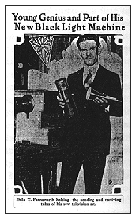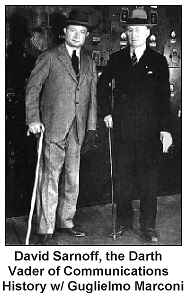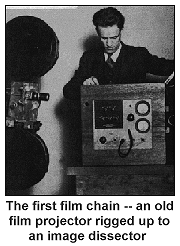SF MAN'S INVENTION
TO REVOLUTIONIZE TELEVISION
 The Image Dissector was described as being the size of "an ordinary quart jar that a housewife
uses to preserve fruit." The article was accompanied by a front page photo of the newly
mustachioed Philo T. Farnsworth, posing as he would a hundred times with his magic jars in
hand.
The Image Dissector was described as being the size of "an ordinary quart jar that a housewife
uses to preserve fruit." The article was accompanied by a front page photo of the newly
mustachioed Philo T. Farnsworth, posing as he would a hundred times with his magic jars in
hand.
The sudden flurry of publicity surprised no one, least of all the backers, some of whom had begun courting the press in anticipation of a refinancing deal. Unknown to Phil at the time, George Everson and Jess McCargar were quietly negotiating to cash out the rest of the Crocker Group, including Crocker, Fagan and Bishop.
Not long after the Chronicle article appeared, fire swept through the second floor of 202 Green Street, charring all of Farnsworth's equipment. The disaster underlined the hazards involved in Phil's research: some of the chemicals they used, like potassium, were highly volatile; vacuum tubes were still very fragile, and would occasionally implode without warning; and there was always the lingering possibility that someone would touch the wrong terminal and get a blast from the strong currents and high voltages that were always present.
Phil and the "lab gang" rebuilt quickly after the fire, hardly losing a stride in their frantic pace to make their invention commercially viable. Natural disasters could not stop Farnsworth, but the uncertainty of human nature could. In 1929, the activity backstage began to come to a head. Phil knew that changes were imminent when his funds were unceremoniously shut off. Under these conditions, he was faced with the unpleasant task of dismissing some of his men. Farnsworth rose to the task reluctantly, for he was being asked to lay off the only people in the world who really understood what he was doing and the way he was doing it. He had trained most of these men personally, and felt that, as an investment, they were worth much more than the wage that they were paid. The "lab gang" was an invaluable resource, the driving force that could make all the magic happen. Phil assured everybody that he would rehire them just as soon as the financing was straightened out.
 When the smoke finally cleared at Crocker Bank, Jess McCargar was no longer employed there,
for reasons that have never been explained. Nevertheless, either inspite of losing his job -- or
because of it -- McCargar and George Everson succeeded in buying out the remainder of the
Crocker Group. Leaving Bishop, Fagan and the others behind, George and Jess reincorporated
the venture as Television Laboratories Inc. and Jess was declared president and chief executive.
George was named treasurer and Farnsworth, who continued to own a substantial share of the
enterprise, was named the Director of Research.
When the smoke finally cleared at Crocker Bank, Jess McCargar was no longer employed there,
for reasons that have never been explained. Nevertheless, either inspite of losing his job -- or
because of it -- McCargar and George Everson succeeded in buying out the remainder of the
Crocker Group. Leaving Bishop, Fagan and the others behind, George and Jess reincorporated
the venture as Television Laboratories Inc. and Jess was declared president and chief executive.
George was named treasurer and Farnsworth, who continued to own a substantial share of the
enterprise, was named the Director of Research.
After squaring with the Crocker Group, Jess McCargar proposed to raise new funds for research by floating a stock issue. The task suited McCargar perfectly. This was, after all, the age of "beautiful nonsense" in the financial world and Jess McCargar was a creature of the times. He was a stock peddler by trade, and had amassed a small fortune as a promoter of speculations and fancy ventures. Television seemed to McCargar like a high promotable affair. The simple mention of the word in his circles seemed to evoke tremendous curiosity. Prospective investors always asked to see it for themselves, and once they came face to face with the electronic marvel, they were invariably impressed with what they saw. Television sold itself right from the beginning, so McCargar had no trouble finding an adequate market for his stock.
Farnsworth accepted the new circumstances with cautious enthusiasm. He was immeasurably grateful for the opportunity to resume his work, and he was certain that the threat of a sell out had been averted, at least for the time being. Still, the situation seemed far from perfect. There was a lingering aroma around all these financial shenanigans. But Phil concealed his ill-ease from his friends and colleagues by assuring them with hollow confidence that "everything would work out all right."
Back East, the news of a breakthrough on the West Coast spread quickly among the giants of the electronics industry. However, the important details of Farnsworth's work remained a closely guarded secrets while the patents were still pending. Most of the old professors were content to wait for further developments while they continued to experiment with their spinning wheels. But one interested party wasn't taking any chances: David Sarnoff, the recently appointed vice-president and General Manager of the vast Radio Corporation of America, wanted to know exactly what was happening at 202 Green Street.
 Sarnoff was a feisty Russian emigre who reputedly got his first taste of the power of modern
communications the night he reported the sinking of the Titanic to the world from his post on
the wireless for American Marconi -- just one of the many Sarnoff legends that have since been
debunked. Regardless of the credibility of the story, Sarnoff's star rose quickly when Marconi
was absorbed by the government spawned Radio Corporation after World War I.
Sarnoff was a feisty Russian emigre who reputedly got his first taste of the power of modern
communications the night he reported the sinking of the Titanic to the world from his post on
the wireless for American Marconi -- just one of the many Sarnoff legends that have since been
debunked. Regardless of the credibility of the story, Sarnoff's star rose quickly when Marconi
was absorbed by the government spawned Radio Corporation after World War I.
Sarnoff built his career on a reputation for predicting the future of the electronics business. He was instrumental in shaping radio broadcasting along the lines of a memo that he wrote long before the word "broadcasting" became common usage. In the 1920's, he managed his company's patent portfolio to the point that it was virtually impossible to manufacture or sell radio equipment without paying royalties to RCA.
In the late 1920's, Sarnoff realized that most of the fundamental patents covering radio would soon reach the end of their 17 year terms and expire. He also reasoned that some new kind of radio device would be invented that would eventually make the existing patents obsolete. Sarnoff concluded that if RCA could get a handle on that new kind of radio before anyone else, then he could manage the introduction of the new invention in such a way as to maximize RCA's return on the old radio patents before they expired. In other words, if he controlled the new development as well as he controlled the old ones, then he could stall the new developments long enough to milk the existing radio patents for every day of their year term.
It comes as no surprise then that the new development which seized Sarnoff's ambition was not radio at all, but radio-with-a-picture. Sarnoff observed that every time there was a flurry of publicity about television, radio sets sales softened slightly, as consumers held onto their money in anticipation of something better. What Sarnoff saw was enough to convince him that visual broadcasting would one day dwarf its sound-only predecessor.
Consequently, in order to head off the threat that a new industry would obsolesce his own, Sarnoff proposed to sire the new industry himself. He began in 1930 by acquiring the services of one Vladimir K. Zworykin, a research engineer who had some experience in television. Zworykin -- like Sarnoff, a Russian emigre -- was introduced to the concept of television by a Russian scientist named Boris Rosing, who proposed a partially electronic television system in 1906. Zworykin carried Rosing's ideas with him when he fled Russian in the early 1920's and came to America, where he found work with Westinghouse as a researcher. While working for Westinghouse in 1923, Zworykin applied for a patent for a completely electronic television system, but the patents were never granted and Westinghouse failed to see much promise in the work so it was dropped.
 In 1930 Sarnoff learned of Zworykin's experience and arranged for Zworykin to resume his work
with RCA's blessing at their well-equipped research facility in Camden, N.J. Zworykin was
packing his bags, preparing to move from Pittsburgh to Camden in the early Spring of 1930
when Sarnoff suggested he "stop off" in San Francisco first, to see if this upstart young inventor
had invented anything that RCA would need to advance their own research. Sarnoff included one
notable detail in his instructions: Zworykin was to approach Farnsworth on his own, in his
present capacity, as an engineer for Westinghouse, investigating the possibility of a patent
license. Zworykin's next destination after San Francisco -- Camden -- was not to be discussed.
In 1930 Sarnoff learned of Zworykin's experience and arranged for Zworykin to resume his work
with RCA's blessing at their well-equipped research facility in Camden, N.J. Zworykin was
packing his bags, preparing to move from Pittsburgh to Camden in the early Spring of 1930
when Sarnoff suggested he "stop off" in San Francisco first, to see if this upstart young inventor
had invented anything that RCA would need to advance their own research. Sarnoff included one
notable detail in his instructions: Zworykin was to approach Farnsworth on his own, in his
present capacity, as an engineer for Westinghouse, investigating the possibility of a patent
license. Zworykin's next destination after San Francisco -- Camden -- was not to be discussed.
Why Sarnoff wanted to know what he was dealing with before Farnsworth learned who he was dealing with is not completely clear. The answer no doubt lies in a tradition which Sarnoff intended to maintain with television, a bold, but unwritten, policy which supplied the cornerstone of RCA's impenetrable patent portfolio: "The RCA doesn't pay patent royalties," Sarnoff allegedly told a colleague once, "we collect them."
This policy served successfully throughout the 1920's, as RCA acquired control of the patents of Marconi, Armstrong, Deforest and others and guided RCA's legal forces through a long string of successful litigation that put dozens of small companies out of business for failure to pay patent royalties to RCA. Knowing that Sarnoff was bound to this policy, it is easier to understand that he might not want this new competitor to know that RCA was entering the arena on an all-or-nothing basis.
As it is difficult to accurately interpret Sarnoff's motivations, it is equally difficult to assess whether Zworykin would have received a similar reception were he flying his true colors. Farnsworth tended to accept anyone who was articulate in the subject as a fellow traveler on the video frontier. Zworykin took full advantage of Farnsworth's hospitality.
 A formal examination of new patents and the work that they cover is common practice in
negotiating for a patent license. But Zworykin "prowled around" Farnsworth's lab for three full
days, during which time he had ample opportunity to expose himself to most of the secrets that
made 202 Green Street the only address in the world with true television. Zworykin's response to
Phil's work was for the most part cautiously complimentary. He was familiar with Phil's cathode
ray tube receiver: Zworykin himself produced some noticeable results with a similar receiver in
1929, two years after Farnsworth--but the absence of a suitable electronic camera device
confined him to the use of spinning wheels on the input end during the early '30's. His work on
the picture tube was retarded by all the limitations inherent in the spinning disc approach: The
system could not produce any more than 40 or 50 lines per frame because the receiver could
produce no more detail than was sent by the transmitter.
A formal examination of new patents and the work that they cover is common practice in
negotiating for a patent license. But Zworykin "prowled around" Farnsworth's lab for three full
days, during which time he had ample opportunity to expose himself to most of the secrets that
made 202 Green Street the only address in the world with true television. Zworykin's response to
Phil's work was for the most part cautiously complimentary. He was familiar with Phil's cathode
ray tube receiver: Zworykin himself produced some noticeable results with a similar receiver in
1929, two years after Farnsworth--but the absence of a suitable electronic camera device
confined him to the use of spinning wheels on the input end during the early '30's. His work on
the picture tube was retarded by all the limitations inherent in the spinning disc approach: The
system could not produce any more than 40 or 50 lines per frame because the receiver could
produce no more detail than was sent by the transmitter.
Reassembling an image on a photo cathode in an evacuated bottle--converting electricity back into light -- was the easy side of the equation. Converting values of light into values of electricity was the missing ingredient that had eluded Zworykin and his contemporaries for so long. The stroke of true genius was required to solve that one. Now Philo T. Farnsworth -- twenty years Zworykin's junior -- showed him what he'd been missing.
Zworykin dropped his tone of guarded praise for a moment when Farnsworth finished explaining the Image Dissector. His response revealed genuine admiration, which is not often shared between competing inventors. And numerous eyewitnesses were present to hear Zworykin concede, "this is a beautiful instrument. I wish I'd invented it."
Despite such honest sentiments, at the end of his visit, Zworykin's mood changed. Though he had been clearly impressed with Farnsworth's invention, he was now reluctant to discuss the matter of a license any further. The entire matter was left up in the air.
There was an ominous tone in Zworykin's sudden reversal that rattled everyone in the lab. He seemed so impressed one minute, so disinterested the next. Later that night, Phil wondered aloud to Pem if perhaps he had shown Zworykin too much.

 1977, 1995 Paul Schatzkin; All Rights Reserved
1977, 1995 Paul Schatzkin; All Rights Reserved